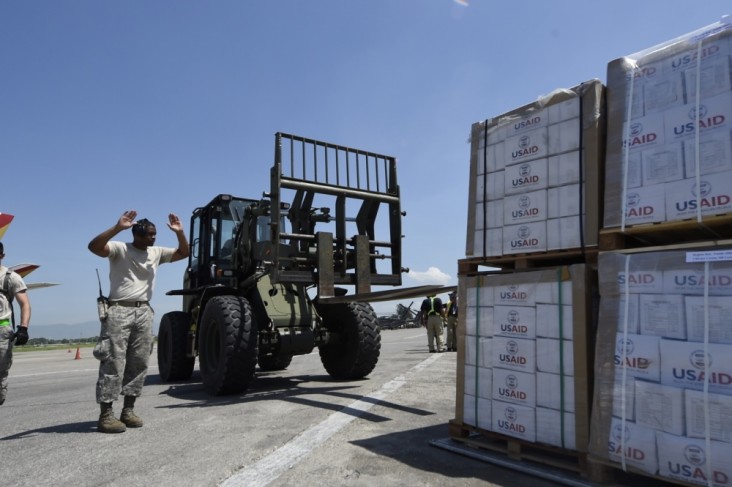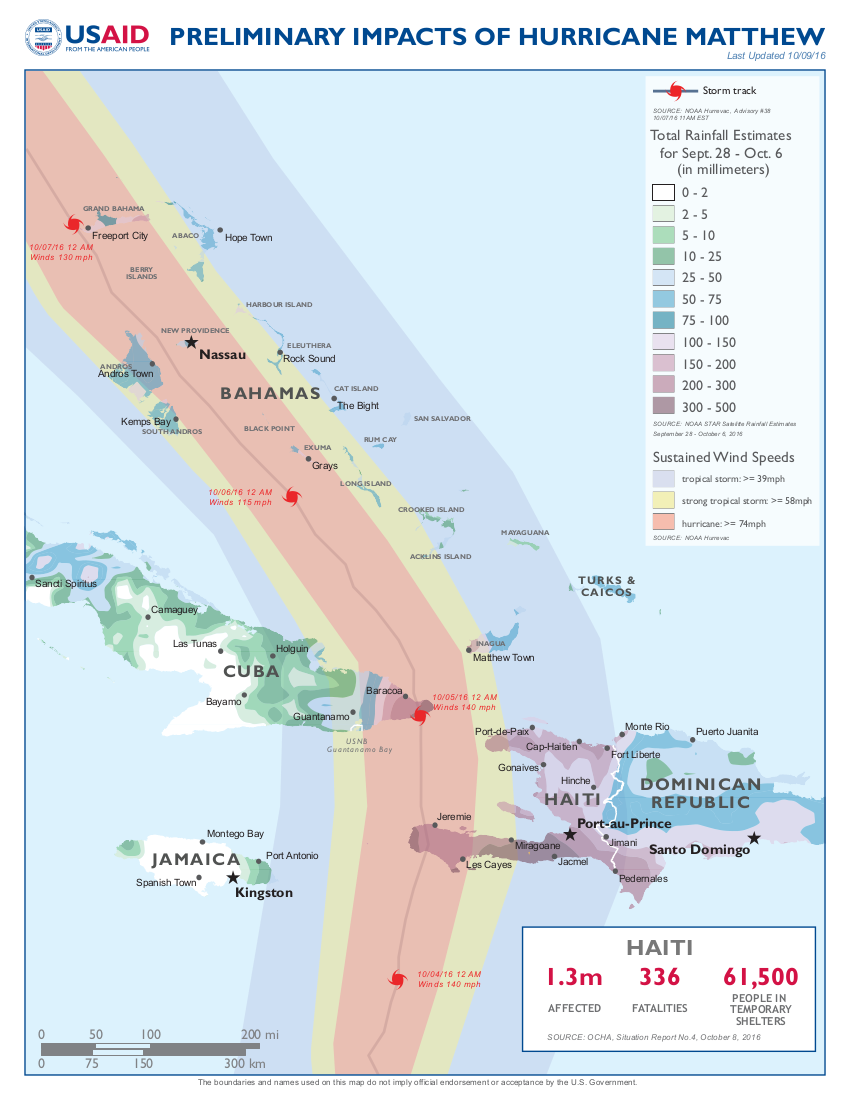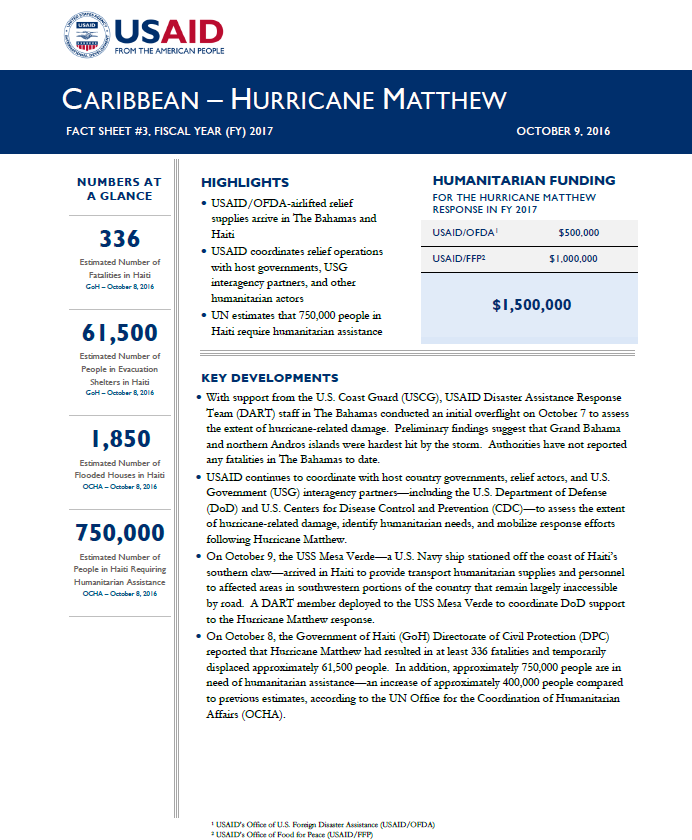Speeches Shim

October 9, 2016
Highlights
USAID/OFDA-airlifted relief supplies arrive in The Bahamas and Haiti
USAID coordinates relief operations with host governments, USG interagency partners, and other humanitarian actors
UN estimates that 750,000 people in Haiti require humanitarian assistance
Key Developments
Numbers At A Glance
336
61,500
1,850
750,000
Humanitarian Funding
For the Hurricane Matthew Response
in FY 2017
| USAID/OFDA | $500,000 |
| USAID/FFP | $1,000,000 |
| TOTAL | $1,500,000 |
With support from the U.S. Coast Guard (USCG), USAID Disaster Assistance Response Team (DART) staff in The Bahamas conducted an initial overflight on October 7 to assess the extent of hurricane-related damage. Preliminary findings suggest that Grand Bahama and northern Andros islands were hardest hit by the storm. Authorities have not reported any fatalities in The Bahamas to date.
USAID continues to coordinate with host country governments, relief actors, and U.S. Government (USG) interagency partners—including the U.S. Department of Defense (DoD) and U.S. Centers for Disease Control and Prevention (CDC)—to assess the extent of hurricane-related damage, identify humanitarian needs, and mobilize response efforts following Hurricane Matthew.
On October 9, the USS Mesa Verde—a U.S. Navy ship stationed off the coast of Haiti’s southern claw—arrived in Haiti to provide transport humanitarian supplies and personnel to affected areas in southwestern portions of the country that remain largely inaccessible by road. A DART member deployed to the USS Mesa Verde to coordinate DoD support to the Hurricane Matthew response.
On October 8, the Government of Haiti (GoH) Directorate of Civil Protection (DPC) reported that Hurricane Matthew had resulted in at least 336 fatalities and temporarily displaced approximately 61,500 people. In addition, approximately 750,000 people are in need of humanitarian assistance—an increase of approximately 400,000 people compared to previous estimates, according to the UN Office for the Coordination of Humanitarian Affairs (OCHA).
ACCESS
The Bahamas
DART staff in The Bahamas conducted an overflight assessment of New Providence, Grand Bahama, and northern Andros islands, as well as the Berry island chain, on October 7 to examine the extent of hurricane-related damage in The Bahamas. Preliminary findings suggest some flooding and widespread power outages and structural damage, with up to 90 percent of houses damaged in some areas. In coordination with the Bahamas Power and Light Company, the Government of the Commonwealth of the Bahamas (GCoB) Ministry of Public Works began clearing roadways and restoring power to residents of New Providence on October 8. The GCoB National Emergency Management Agency conducted additional assessments in New Providence, Grand Bahama, and northern Andros on October 9 to better assess humanitarian needs resulting from the storm.
On October 8, Grand Bahama International Airport, located in Freeport city, opened to facilitate the delivery of relief commodities transported via humanitarian flights; Lynden Pindling International Airport in The Bahamas’ capital city of Nassau has also opened to commercial flights.
Haiti
The GoH DPC is working to improve road access to facilitate the delivery and distribution of food, medical supplies, and safe drinking water to affected populations. Southern areas of the country—particularly in the departments of Grand’Anse and Sud—remain hard to reach, with many roads still impassable and communication still not intact. Hurricane-related damage to roads and bridges has interrupted transport connections between Sud’s Les Anglais commune and other population centers, such as Sud’s Port Salut commune. As of October 8, residents of Les Anglais reported that they had not received any humanitarian assistance following the storm. The DART is prioritizing assistance to Les Anglais to reach the isolated populations as soon as possible.
According to the DPC, the GoH Ministry of Transportation and Public Works had re-established partial road access along the southern coast of Sud and Nippes departments, which were hard-hit by the storm, as of October 8. The road from Les Cayes commune to Jeremie commune—previously inaccessible due to hurricane damage—is now accessible to four-wheel drive vehicles, according to the Pan American Health Organization (PAHO). The UN Stabilization Mission to Haiti (MINUSTAH) is working to make the road accessible to larger trucks, which would facilitate the rapid delivery of humanitarian assistance to hard-to-reach communities.
LOGISTICS AND HUMANTIARIAN COORDINATION
The Bahamas
USAID/OFDA airlifted relief commodities—including approximately 1,000 blankets, 1,000 hygiene kits, 540 kitchen sets, 300 rolls of plastic sheeting, and 1,200 water containers—to Nassau for forward distribution to approximately 5,000 beneficiaries in The Bahamas on October 8. USAID/OFDA is also coordinating a second airlift of relief supplies to Nassau, comprising approximately 30 generators and additional kitchen sets, scheduled for arrival during the week of October 10.
On October 8, two USCG aircraft transported humanitarian personnel and supplies from New Providence to Andros, where power and water supplies remain disrupted.
Haiti
Relief actors in Haiti have begun organizing working groups to coordinate health, logistics, protection, and other humanitarian activities; however, as of October 9, the UN had not activated the formal cluster system.
On October 7, a logistics response team—with assistance from the Global Logistics Cluster in Rome, Italy, and the UN World Food Program (WFP) Regional Bureau in Panama—deployed to Haiti to establish a logistics working group in Port-au-Prince, according to the Logistics Cluster, the coordinating body for humanitarian logistics and coordination activities. The logistics working group in Haiti, with participation from the DPC, the International Organization for Migration, WFP, and the DART, conducted an overflight of the southern claw on October 7 to assess logistics potential for future airlifts and distributions of food and relief commodities to Jeremie and Les Cayes.
On October 8, PAHO also began convening health working group partners to coordinate health-related response activities.
On October 9, a flight carrying USAID/OFDA relief commodities—including 14,600 blankets to benefit approximately 36,500 people and 1,000 rolls of plastic sheeting to benefit approximately 50,000 people—arrived in Port-au-Prince. The shipment follows two airlifts, comprising approximately 10,600 blankets, 12,800 hygiene kits, 10,860 kitchen sets, and 610 rolls of plastic sheeting, which arrived in Port-au-Prince on October 8. In total, USAID/OFDA plans to conduct five airlifts, with assistance sufficient for an estimated 100,000 people.
DART staff in Haiti met with representatives of the American Red Cross (AmCross) and the Haiti Red Cross Society (HRCS) on October 8 to discuss the coordination of food and relief commodity distribution using the organizations’ vast volunteer network in country.
DoD continues to support humanitarian logistics and transportation to ensure the rapid delivery of relief commodities to hurricane-affected populations in hard-to-reach areas of Haiti. On October 7, U.S. Southern Command directed USS Mesa Verde—a U.S. Navy ship carrying three helicopters, one landing craft, and 300 Marines—to transit to Haiti. The ship, which arrived in Haiti on October 9, will provide additional airlift and transport capabilities to support the delivery and distribution of critical relief supplies, as well as the transportation of emergency response personnel to hard-to-reach areas, particularly in Haiti’s southern peninsula. The arrival of USS Mesa Verde brings Joint Task Force Matthew’s total footprint to approximately 550 personnel and 12 helicopters.
HEALTH AND WASH
The Bahamas
Preliminary reports from USAID/OFDA staff in The Bahamas indicate that the majority of health facilities across the country are operational. Although the water system on northern Andros had significant damage and flooding in its pumping station, as well significant leaks due to storm related damage, crews were able to partially restore the system and water availability for the community.
Haiti
Humanitarian actors remain concerned that Hurricane Matthew could exacerbate the spread of cholera in Haiti. The DART and in-country staff from USAID’s Bureau for Global Health and CDC continue to collaborate with the GoH Ministry of Public Health and Population (MSPP) and PAHO to ensure a robust health response that will mitigate a surge in cholera cases.
As of October 9, CDC had deployed four staff to support its Haiti country office in assessing the health-related impacts of Hurricane Matthew, enhance disease surveillance activities, and strengthen the capacity of the MSPP. CDC reports that staff are working with representatives of the MSPP and PAHO to enhance field-based disease surveillance, and are coordinating the investigation of reported incidences of suspected cholera with staff from the MSPP and CDC’s Field Epidemiology Training Program. CDC staff are also providing technical support to ensure the continued operations of MSPP’s National Cholera Surveillance System. CDC continues to coordinate closely with the DART, including through a CDC liaison embedded with the DART, and plans to begin conducting assessments of key health care facilities and cholera treatment centers in the coming days. Since 2002, CDC has maintained a country office in Haiti. The office comprises more than 80 staff, including both local and international personnel.
Additional relief actors, including the Agency for Technical Cooperation and Development (ACTED) and the UN Children’s Fund (UNICEF), are supporting interventions to prevent and treat cholera in hurricane-affected communities, according to USAID/OFDA staff in Haiti.
On October 8, the DART, with DoD helicopter support, transported non-governmental organization (NGO) St. Boniface Haiti Foundation doctors to Sud to assess needs and damages at a previously inaccessible USAID-funded hospital on Ile-a-Vache Island, as well as in other health care facilities in Les Anglais. The doctors reported that the hurricane had resulted in nearly 180 deaths and approximately 700 injuries in communities near the center of the commune. The assessment identified significant health and water, sanitation, and hygiene (WASH) needs, including limited access to safe drinking water, prompting populations to consume water from unprotected sources. The local hospital had also exhausted many medical supplies.
In Grand’Anse, UNICEF is working with the GoH National Directorate of Water Supply and Sanitation (DINEPA) and providing water storage units to repair damaged water supply systems. UNICEF has identified needs for water purification tablets, sanitation facilities, vehicles for transporting equipment, and additional water storage units. As of October 8, DINEPA had deployed technicians and emergency WASH supplies—including water purification tablets and water storage units—estimated to benefit approximately 10,000 people in severely-affected areas of Grand’Anse and Sud.
DISPLACEMENT, PROTECTION, AND SHELTER
The Bahamas
According to a U.S. National Geospatial Intelligence Agency preliminary damage assessment, Hurricane Matthew damaged approximately 100 houses and destroyed more than 50 houses on New Providence. Additionally, a USAID/OFDA consultant in The Bahamas reports that approximately 35 people remained in a shelter on Grand Bahama, as of October 9.
Haiti
On October 8, the GoH DPC reported that Hurricane Matthew had displaced approximately 61,500 people to more than 190 temporary shelters and flooded more than 1,850 houses countrywide. Humanitarian actors continue to identify shelter needs and coordinate shelter-related response operations.
Officials in Les Anglais—where Hurricane Matthew first made landfall—estimate that only 80 houses of 4,000 houses in the commune remain intact following the storm, according to relief personnel who visited the commune during a DART-coordinated assessment. As a result of the destruction, the majority of residents in Les Anglais were sleeping in open areas as of October 8.
On October 9, UNICEF reported that the hurricane damaged approximately half of Haiti’s orphanages and destroyed at least three orphanages. UNICEF also reported several protection-related concerns arising from the storm, including a need for family-tracing and reunification of children placed at shelters by caregivers due to poverty. UNICEF is advocating with NGO partners to increase child protection and gender-based violence response services, as well as monitor child trafficking.
The GoH plans to reopen schools on October 10; however, as of October 8, more than 150 schools remained in use as shelters, according to UNICEF.
FOOD SECURITY
In coordination with the GoH and the UN Food and Agricultural Organization, USAID/FFP partner WFP is conducting emergency food security assessments in the departments of Grand’Anse, Nord-Ouest, Sud, and Sud-Est and reports up to 95 percent harvest loss in some coastal areas.
On October 8, WFP transported approximately 114 metric tons (MT) of emergency food assistance—including pulses, oil, and rice—to severely affected communities in Les Cayes and Jeremie. WFP transported approximately 100 MT to Les Cayes via an overland route, while the DART coordinated the delivery of 14 MT of WFP-procured emergency food assistance via DoD helicopter rotations. WFP plans to airlift approximately 20 MT of High Energy Biscuits from its warehouse in Dubai, United Arab Emirates, in the coming days.
OTHER HUMANITARIAN ASSISTANCE
At the request of the GoH, the Caribbean Disaster Emergency Management Agency (CDEMA) has deployed a sixmember operational support team to assist with emergency operation center coordination in the hard-hit communes of Jeremie and Les Cayes. CDEMA has also sent three rapid needs assessment teams to The Bahamas to facilitate damage assessments and needs analysis in Andros, Grand Bahama, and New Providence islands. In addition, CDEMA has activated the regional coordination center at the CDEMA Coordinating Unit and placed other support arrangements for Haiti on standby.
On October 7, the Central Emergency Response Fund (CERF)—a pooled humanitarian fund established and managed by the UN to support sudden-onset and underfunded emergencies—announced a $5 million allocation to support the initial emergency response to hurricane-related needs in Haiti. In addition, prior to Hurricane Matthew’s arrival, CERF had approved an $8 million loan to UNICEF in Haiti to scale up operations to mitigate the spread of cholera, the incidence of which had already been increasing in the months preceding the storm.
As of October 7, the E.U. had committed approximately €1.75 million—or nearly $2 million—to address immediate needs in Haiti following the passage of Hurricane Matthew. The E.U. also reported that a team of 11 civil protection experts from Denmark, Finland, France, Romania, and Sweden was scheduled to arrive in Haiti by October 8 to provide technical assistance to the GoH and the humanitarian community.
The Government of the UK announced on October 7 that it is committing up to £5 million—or approximately $6.2 million—in initial assistance to hurricane-affected populations in Haiti. The aid includes a delivery of shelter kits for 5,000 people and other emergency relief commodities on October 7, as well as additional shipments of temporary shelters, water purification and storage equipment, and solar lights for 12,500 people that are scheduled to arrive in country over the coming days. Meanwhile, the Government of France (GoF) has chartered a plane to deliver two water purification stations, cholera treatment kits, and other essential relief items to Haiti; the flight will also transport 60 experts to operate the stations and provide other technical assistance. Two helicopters—provided through a partnership between the GoF and the Airbus Helicopters Foundation—are available to conduct aerial reconnaissance missions to help determine the extent of storm damages and to deliver critically needed medical and other supplies to remote areas of Haiti.
The Government of Canada (GoC) had deployed a six-member disaster evaluation team to Haiti as of October 6 to assess needs and determine the GoC’s response. The GoC has also committed an initial 3 million Canadian dollars—or $2.3 million—to provide immediate assistance, such as food, shelter, and basic health care, in Haiti and other countries in the region affected by Hurricane Matthew.
On October 7, the Government of Japan announced plans to provide emergency relief items, including tents, to Haiti via the Japan International Cooperation Agency.
CONTEXT
Hurricane Matthew made an initial landfall near Haiti’s Les Anglais commune, Sud Department, on October 4, before making a secondary landfall over eastern Cuba on October 4 and continuing to traverse The Bahamas from October 5–6. The storm brought destructive winds, heavy rainfall, and dangerous storm surge, resulting in extensive damage to crops, houses, and infrastructure, as well as widespread flooding in some areas.
On October 2, U.S. Ambassador to Haiti Peter F. Mulrean and U.S. Chargé d’Affaires, a.i., for Jamaica Eric Khant issued disaster declarations in response to the anticipated effects of Hurricane Matthew in Haiti and Jamaica, respectively. U.S. Chargé d’Affaires, a.i., Lisa A. Johnson issued a disaster declaration in response to the anticipated effects of Hurricane Matthew in The Bahamas on October 3.
USAID activated a regional DART on October 3 with staff in The Bahamas, Haiti, and Jamaica. In addition, USAID stood up a Washington, D.C.-based RMT to coordinate the regional humanitarian response.



Comment
Make a general inquiry or suggest an improvement.